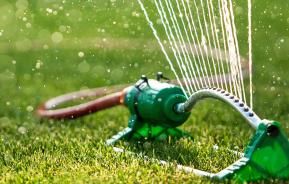
Lawn care tips and tricks – how to get the best lawn
A well-maintained lawn is often the centrepiece of a prized garden but creating that picture-perfect green carpet takes a little planning, time and effort. Whether you prefer patches of wildflowers, or like to keep the grass neatly trimmed, lawns offer an invaluable habitat for many invertebrates and other contributors to your garden’s vital ecosystem. A healthy lawn doesn’t just look great – it will also help keep your garden cool during the summer, release oxygen and capture dust, helping to keep you and your family in better health.
Although maintenance can seem challenging, there are some easy lawn care tips and tricks to improve your lawn and keep your garden looking lush and green.
How to get the best lawn – tips for mowing your grass
To maintain a healthy lawn, look to mow your grass once a week during the summer months, dropping back to once every two weeks during spring, autumn and warm winters. Longer grass generally equates to healthy grass due to the resulting improved root spread, so by keeping your grass 7.5 - 10cm (3 – 4 inches) tall, you may actually reduce the number of weeds that germinate.
That said, allowing for some length variation throughout the seasons can stimulate growth and maximise the health of your lawn. At the beginning of the year, you can cut the grass to approximately 2.5 – 4 cm (1 – 1.5 inches). This allows for the dead grass to be removed, and for sunlight to reach the root more easily. A scalped lawn is prone to developing moss, so never go beneath this length, even when removing dead grass at the beginning of the year.
Regardless of when you’re mowing the lawn throughout the year, don’t forget to keep your mower blades sharp and the bottom of your mower clean. A blunt blade will tear the grass rather than cleanly cutting it, meaning the ends of the grass blades may turn yellow. If this happens, don’t panic; this grass will grow out with no lasting effect, but do remember to sharpen and balance your blade before your next mow.
Edging your lawn
In the quest for a perfect lawn, well-trimmed, neat edges are essential. Use a pair of long-handled shears to define the edge of your lawn, or, if the boundary between borders and lawn has become a little blurred, cut new edges with a half-moon spade. This useful tool has a sharp curved blade for cutting down into old turf to create a new edge. If needed, it can also be used as a spade to lift out the cut turf and make a channel around the edge of the border.
You can also use a strimmer to keep the lawn edges tidy and grass heights consistent across your garden. If you have some old planks of wood lying around, you can trim against these for perfectly straight lines – a firm hose pipe can be used to maintain a consistent curve.

How to improve lawn health - watering and feeding
If you’ve done any research on how to get the perfect lawn, you’ll know that a perfect lawn is a healthy lawn. The health of your lawn is largely dependent on the right combination of watering and feeding and, while this isn’t necessarily complicated, the ideal combination will depend upon the prevailing conditions.
Feeding your lawn
Ensuring your lawn receives the appropriate amount of water is only half of the battle – to achieve healthy grass coverage, it’s essential to nourish it with a lawn feed. Spring and midsummer are traditionally the most ideal times to do this, but make sure you read the advice on your feed packaging first, as the optimum time will vary from product to product. Miracle-Gro Complete Lawn Food for example, is appropriate for a spring feed, while a better option for summer would be Miracle-Gro Fast Green Liquid Concentrate.
Feeding your lawn in early spring will encourage root growth throughout the summer, and then you can just top it up on a regular basis. If your grass is looking a bit thin, you can always use a lawn thickener such as Miracle-Gro Thick’R Lawn to give it more density.
Make sure that you apply plant feed to the grass when rain is forecast so that it gets washed down to the roots and stops it from burning the leaf blades. If no rain appears, then you can water the lawn yourself. Using a sprayer attachment on your hose pipe allows you to feed and water your lawn at the same time.
To protect your grass throughout the winter and to cultivate a healthy lawn come spring, be sure to apply an autumn-specific lawn feed such as Miracle-Gro Evergreen Autumn Lawn Care and always make sure you follow the guidance on the packaging to avoid causing inadvertent damage to your garden.
Weed control
If you’ve followed all of the above advice and you’re still tearing your hair out over how to get the perfect grass, it may be time to consider enlisting the help of weed control for lawns.
Lawn weeds tend to be tough, perennial, low-growing plants that are resistant to regular mowing and foot traffic. They are often quick to colonise any bare or patchy areas, meaning the best defence against weeds is a healthy lawn, with good root depth and grass density helping to prevent weed growth. As many common weeds are also considered to be native wildflowers, many gardeners now choose to leave some curated patches within or at the edges of their lawns to improve their garden’s biodiversity. If you want to limit the spread of these areas to the remainder of your lawn, then remember to regularly deadhead or mow low-growing weeds.
Where weeds require removal, isolated weeds can be tackled by hand and early in their lifecycle (ideally spring) is the optimal time to do so. There are many different weeding tools on the market, including those that can be used from a standing position and those designed for deeper root systems.
If you have a more endemic, established weed problem then this is when it may be time to consider using a weed control product. Make sure you have one that’s suitable both for your lawn and for the type of weed you’re looking to treat. If it’s not specifically designed for lawns then it may damage or kill your grass, too! An ideal solution is a combined weed control and lawn feed product, as this will encourage deep roots and thick coverage in your grass, helping to prevent future weeds.
There are a number of things to take into account when applying gardening products to your lawn. These are mainly location, weed type, condition of the soil, and grass type. If you want to know more, check our guides for identifying weeds and using weed control.
Maintaining healthy grass
Remember that maintaining a ‘perfect’ lawn year-round is almost impossible – especially if you’re picturing thick, perfectly manicured vibrant green grass. Lawns are living things and have a natural lifecycle, which is impacted by the elements throughout the seasons, so it may be useful to put together a seasonal plan for your lawn.
The best thing you can do is give your lawn a helping hand to stay as healthy as possible – sometimes that will mean letting the grass grow a bit longer, and sometimes it may mean enduring tough droughts. Focus on how to improve your grass health, and you’ll likely avail of that picture perfect lawn when spring and summer rolls around.











